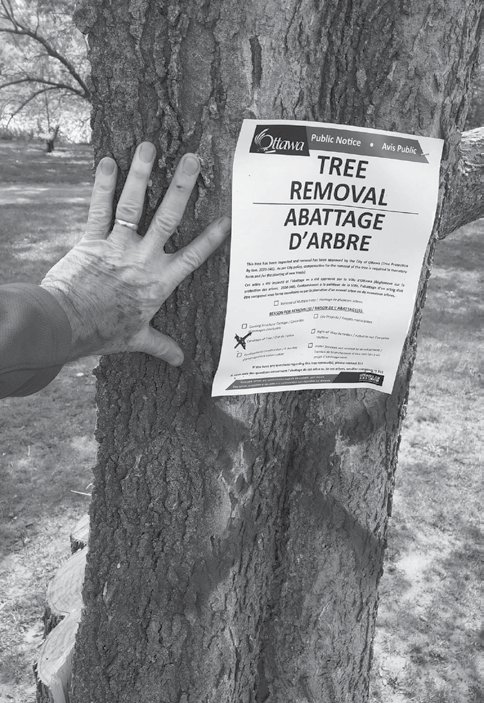Darlene Pearson
I always feel a sense of loss when I see the large red “X” dooming yet another mature neighbourhood tree. With each severe weather event, fatal red Xs lead to the removal of ever more of the gentle giants that silently provide us beauty and much-needed summertime shade. Seeing the profusion of Xs prompted me to ask the City about its criteria for removing trees, and what its plans were for their replacement.
Tracey Schwets, the program manager for the City’s Forestry Management Branch, explained that, in addition to the red X, the City posts a “Public Notice of Tree Removal” consistent with the City’s Tree Protection bylaw. This notice gives a general reason for the tree’s removal.
The decision to remove a tree is taken after a full tree assessment, considering aspects such as crown defoliation, decay, trunk damage, presence of pests, and risk to property. Schwets explained that the City’s goal is to maintain trees as long as possible through structural pruning to reduce the tree’s weight load and other measures such as cabling to support large branches. The City’s tree maintenance program has a seven year pruning cycle, she said, in addition to responding 24/7 to service calls and emergency situations. There is also some annual inspection by the forester assigned to each ward.
Currently tree planting is primarily reactive based on requests, including those through the Trees in Trust program. This program offers free trees to property owners whose front yards abut the City right-of-way along streets. Trees in Trust supplies a variety of large and medium growing trees as well as small trees suited to limited spaces. The species available rotate with each season to diversify the species planted. Replacement of dead trees, including those lost to severe weather events, requires seasonal planning and scheduling as well as proper siting to avoid underground and above ground utilities. Stump removal must take place before replanting, with large weather events delaying removal because of high volume and competing priorities.
The City is currently working on a tree planting strategy, a component of its Urban Forest Management Plan. This strategy will review Ottawa’s current planting programs, including Trees in Trust.
“The goal of the review is to increase tree canopy in neighbourhoods with low tree cover, which will require solutions for proactive planting in the right-of-way adjacent to non-owner occupied properties,” Schwets said. This is good news for urban core neighbourhoods where many properties are owned by non-resident landlords.
The other good news is that there will be an opportunity in 2024 for the public to provide input on existing programs to help inform changes and identify gaps. The City is reassessing its urban forest canopy and will use public input to inform the prioritization of tree planting locations. Schwets mentioned that the results of this reassessment should be finalized early in 2024, with information being publicly available shortly thereafter.
There are also plans to undertake a “plantable spaces” study to identify locations to prioritize planting efforts.
I think we all realize how difficult growing conditions are for trees in the dense urban core: lack of adequate soil volume to support mature trees; hard surfaces that prevent rainwater reaching tree roots; impacts from road salt and snow removal operations; vandalism; and pruning for utilities.
In addition to these inner city planting limitations, the City must also deal with climate change impacts. So what is it doing? The City plants salt-tolerant species such as Hackberry, Ginkgo, Serviceberry, Honey Locust, and others. It is testing new species that may tolerate a warmer climate such as the Kentucky Coffee Tree and Eastern Red Bud. It has also taken advantage of large infrastructure projects to plant street trees, as was the case with the redevelopment of Elgin Street. All of this offers hope for our community’s trees.







